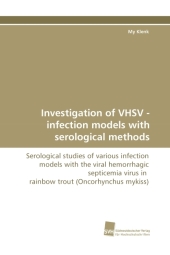 Neuerscheinungen 2010Stand: 2020-01-07 |
Schnellsuche
ISBN/Stichwort/Autor
|
Herderstraße 10
10625 Berlin
Tel.: 030 315 714 16
Fax 030 315 714 14
info@buchspektrum.de |

My Klenk
Investigation of VHSV - infection models with serological methods
Serological studies of various infection models with the viral hemorrhagic septicemia virus in rainbow trout (Oncorhynchus mykiss)
2010. 60 S.
Verlag/Jahr: SÜDWESTDEUTSCHER VERLAG FÜR HOCHSCHULSCHRIFTEN 2010
ISBN: 3-8381-1463-9 (3838114639)
Neue ISBN: 978-3-8381-1463-7 (9783838114637)
Preis und Lieferzeit: Bitte klicken
The viral hemorrhagic septicemia (VHS) is a well known disease of salmonid fish and causes great economical losses, especially in rainbow trout farms. To date, only the detection of the augmentable virus count as a positive result for the presence of the disease. However, for the observation of VHS serological methods as indirect verification would be more advantageous. For a long time serological methods are well established for the indirect detection of viral diseases in mammals. Concerning fish, only few serological tests are described to detect VHS. For the validation of serological tests for the detection of VHSV, sufficient comparative data sets about the specificity and sensitivity are still lacking to date, as well as reproducible models for the infection of trout with the virus. Therefore, the aims of the presented work were a comparative study of a) several approaches to infect rainbow trout with VHSV and b) various methods to detect anti-VHSV-antibodies in the trout s blood.
Since 1979, My (form. Khong Thi) grew up at her forster family Klenk in the Münsterland (D). She studied at the University of Veterinary Science Budapest (HU) and the University of Veterinary Medicine Hannover (D). In 2008, she finished her doctorate at the National Fish Disease Laboratory (NAFUS) in Bern (CH) and is now PostDoc there.


